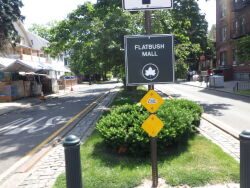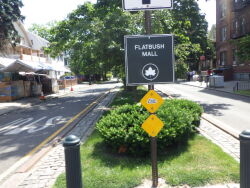Flatbush Malls
Flatbush Malls
Flatbush was one of the original six towns in Brooklyn, colonized by Dutch farmers in 1652. The name is an adaptation of the Dutch appellation Vlacke bos which means “flat woodland.” It remained mostly farmland until the Flatbush and Coney Island Railroad opened in 1878. The increased access turned Flatbush into a proto-suburb, as commuters from the then-separate cities of New York and Brooklyn moved in. The Flatbush Town Hall, built in 1875 and now a New York City Landmark, is a relic of the independent town. In 1894, Flatbush was incorporated into the City of Brooklyn, which then became part of the City of New York when the five boroughs merged in 1898.
The Flatbush Malls sit within the area known as Victorian Flatbush, named because of the dominant architectural style. In the early 1900s, private developers constructed malls like this one to make the neighborhoods they built more attractive. Malls are common in New York’s outer boroughs. Dean Alvord bought 50 acres of farmland in 1898 to develop Albermarle and Kenmore Terraces. He hired the Scottish landscape architect John Aiken to create a rustic suburban neighborhood within the constraints of the Brooklyn street grid, and the result was largely achieved through the creation of these malls. Extending down the center of Albemarle Road, the Flatbush Malls run from Coney Island Avenue to Buckingham Road, then round the corner and continue one block north on Buckingham Road.
Aiken looked to Commonwealth Avenue in Boston, Massachusetts for inspiration. His mall on Albemarle Road is narrower than the malls on Commonwealth Avenue, as it does not include a central promenade like the one along the Boston street. The original landscaping of the malls featured shrubs and flowers, but did not include trees. The malls are now lined with a mixture of pine and oak trees, holly bushes, and other trees and shrubs, as well as seasonal flowers that grace the intersections. As part of the streets, the malls are owned by the New York Department of Transportation while Parks is charged with the planting design and maintenance.
Check out your park's Vital Signs
Clean & Safe
Green & Resilient
Empowered & Engaged Users
Share your feedback or learn more about how this park is part of a
Vital Park System




